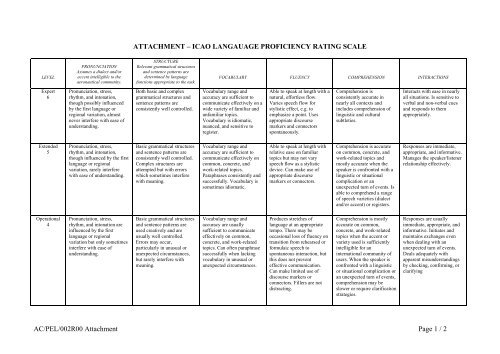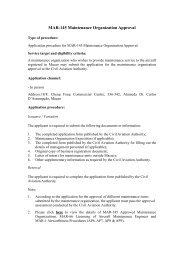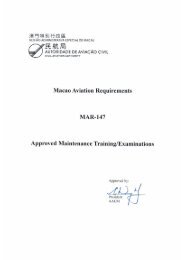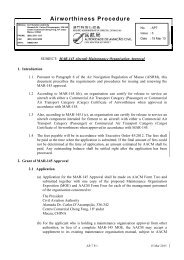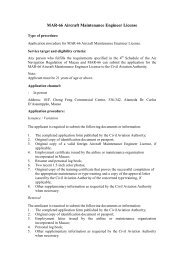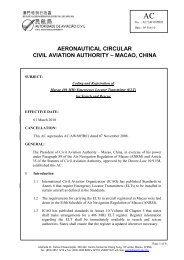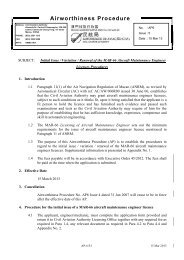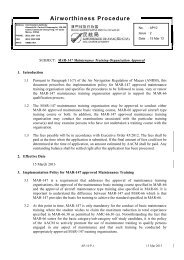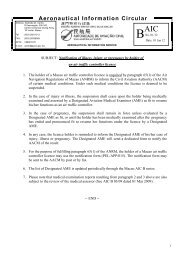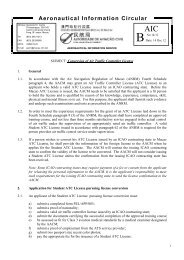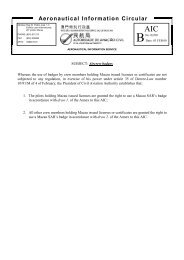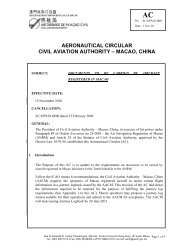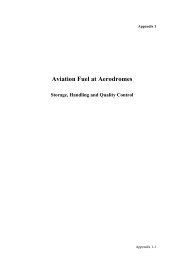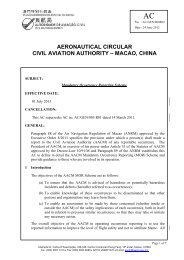AC-PEL-002-R00--Language Proficiency Requirement Attachment
AC-PEL-002-R00--Language Proficiency Requirement Attachment
AC-PEL-002-R00--Language Proficiency Requirement Attachment
Create successful ePaper yourself
Turn your PDF publications into a flip-book with our unique Google optimized e-Paper software.
ATT<strong>AC</strong>HMENT – ICAO LANGAUAGE PROFICIENCY RATING SCALE<br />
LEVEL<br />
PRONUNCIATION<br />
Assumes a dialect and/or<br />
accent intelligible to the<br />
aeronautical community.<br />
STRUCTURE<br />
Relevant grammatical structures<br />
and sentence patterns are<br />
determined by language<br />
functions appropriate to the task.<br />
VOCABULARY FLUENCY COMPREHENSION INTER<strong>AC</strong>TIONS<br />
Expert<br />
6<br />
Pronunciation, stress,<br />
rhythm, and intonation,<br />
though possibly influenced<br />
by the first language or<br />
regional variation, almost<br />
never interfere with ease of<br />
understanding.<br />
Both basic and complex<br />
grammatical structures and<br />
sentence patterns are<br />
consistently well controlled.<br />
Vocabulary range and<br />
accuracy are sufficient to<br />
communicate effectively on a<br />
wide variety of familiar and<br />
unfamiliar topics.<br />
Vocabulary is idiomatic,<br />
nuanced, and sensitive to<br />
register.<br />
Able to speak at length with a<br />
natural, effortless flow.<br />
Varies speech flow for<br />
stylistic effect, e.g. to<br />
emphasize a point. Uses<br />
appropriate discourse<br />
markers and connectors<br />
spontaneously.<br />
Comprehension is<br />
consistently accurate in<br />
nearly all contexts and<br />
includes comprehension of<br />
linguistic and cultural<br />
subtleties.<br />
Interacts with ease in nearly<br />
all situations. Is sensitive to<br />
verbal and non-verbal cues<br />
and responds to them<br />
appropriately.<br />
Extended<br />
5<br />
Pronunciation, stress,<br />
rhythm, and intonation,<br />
though influenced by the first<br />
language or regional<br />
variation, rarely interfere<br />
with ease of understanding.<br />
Basic grammatical structures<br />
and sentence patterns are<br />
consistently well controlled.<br />
Complex structures are<br />
attempted but with errors<br />
which sometimes interfere<br />
with meaning.<br />
Vocabulary range and<br />
accuracy are sufficient to<br />
communicate effectively on<br />
common, concrete, and<br />
work-related topics.<br />
Paraphrases consistently and<br />
successfully. Vocabulary is<br />
sometimes idiomatic.<br />
Able to speak at length with<br />
relative ease on familiar<br />
topics but may not vary<br />
speech flow as a stylistic<br />
device. Can make use of<br />
appropriate discourse<br />
markers or connectors.<br />
Comprehension is accurate<br />
on common, concrete, and<br />
work-related topics and<br />
mostly accurate when the<br />
speaker is confronted with a<br />
linguistic or situational<br />
complication or an<br />
unexpected turn of events. Is<br />
able to comprehend a range<br />
of speech varieties (dialect<br />
and/or accent) or registers.<br />
Responses are immediate,<br />
appropriate, and informative.<br />
Manages the speaker/listener<br />
relationship effectively.<br />
Operational<br />
4<br />
Pronunciation, stress,<br />
rhythm, and intonation are<br />
influenced by the first<br />
language or regional<br />
variation but only sometimes<br />
interfere with ease of<br />
understanding.<br />
Basic grammatical structures<br />
and sentence patterns are<br />
used creatively and are<br />
usually well controlled.<br />
Errors may occur,<br />
particularly in unusual or<br />
unexpected circumstances,<br />
but rarely interfere with<br />
meaning.<br />
Vocabulary range and<br />
accuracy are usually<br />
sufficient to communicate<br />
effectively on common,<br />
concrete, and work-related<br />
topics. Can often paraphrase<br />
successfully when lacking<br />
vocabulary in unusual or<br />
unexpected circumstances.<br />
Produces stretches of<br />
language at an appropriate<br />
tempo. There may be<br />
occasional loss of fluency on<br />
transition from rehearsed or<br />
formulaic speech to<br />
spontaneous interaction, but<br />
this does not prevent<br />
effective communication.<br />
Can make limited use of<br />
discourse markers or<br />
connectors. Fillers are not<br />
distracting.<br />
Comprehension is mostly<br />
accurate on common,<br />
concrete, and work-related<br />
topics when the accent or<br />
variety used is sufficiently<br />
intelligible for an<br />
international community of<br />
users. When the speaker is<br />
confronted with a linguistic<br />
or situational complication or<br />
an unexpected turn of events,<br />
comprehension may be<br />
slower or require clarification<br />
strategies.<br />
Responses are usually<br />
immediate, appropriate, and<br />
informative. Initiates and<br />
maintains exchanges even<br />
when dealing with an<br />
unexpected turn of events.<br />
Deals adequately with<br />
apparent misunderstandings<br />
by checking, confirming, or<br />
clarifying<br />
<strong>AC</strong>/<strong>PEL</strong>/<strong>002</strong><strong>R00</strong> <strong>Attachment</strong> Page 1 / 2
LEVEL<br />
PRONUNCIATION<br />
Assumes a dialect and/or<br />
accent intelligible to the<br />
aeronautical community.<br />
STRUCTURE<br />
Relevant grammatical structures<br />
and sentence patterns are<br />
determined by language<br />
functions appropriate to the task.<br />
VOCABULARY FLUENCY COMPREHENSION INTER<strong>AC</strong>TIONS<br />
Preoperational<br />
3<br />
Pronunciation, stress,<br />
rhythm, and intonation are<br />
influenced by the first<br />
language or regional<br />
variation and frequently<br />
interfere with ease of<br />
understanding.<br />
Basic grammatical structures<br />
and sentence patterns<br />
associated with predictable<br />
situations are not always well<br />
controlled. Errors frequently<br />
interfere with meaning.<br />
Vocabulary range and<br />
accuracy are often sufficient<br />
to communicate on common,<br />
concrete, or work-related<br />
topics, but range is limited<br />
and the word choice often<br />
inappropriate. Is often unable<br />
to paraphrase successfully<br />
when lacking vocabulary.<br />
Produces stretches of<br />
language, but phrasing and<br />
pausing are often<br />
inappropriate. Hesitations or<br />
slowness in language<br />
processing may prevent<br />
effective communication.<br />
Fillers are sometimes<br />
distracting.<br />
Comprehension is often<br />
accurate on common,<br />
concrete, and work-related<br />
topics when the accent or<br />
variety used is sufficiently<br />
intelligible for an<br />
international community of<br />
users. May fail to understand<br />
a linguistic or situational<br />
complication or an<br />
unexpected turn of events.<br />
Responses are sometimes<br />
immediate, appropriate, and<br />
informative. Can initiate and<br />
maintain exchanges with<br />
reasonable ease on familiar<br />
topics and in predictable<br />
situations. Generally<br />
inadequate when dealing<br />
with an unexpected turn of<br />
events.<br />
Elementary<br />
2<br />
Pronunciation, stress,<br />
rhythm, and intonation are<br />
heavily influenced by the<br />
first language or regional<br />
variation and usually<br />
interfere with ease of<br />
understanding.<br />
Shows only limited control of<br />
a few simple memorized<br />
grammatical structures and<br />
sentence patterns.<br />
Limited vocabulary range<br />
consisting only of isolated<br />
words and memorized<br />
phrases.<br />
Can produce very short,<br />
isolated, memorized<br />
utterances with frequent<br />
pausing and a distracting use<br />
of fillers to search for<br />
expressions and to articulate<br />
less familiar words.<br />
Comprehension is limited to<br />
isolated, memorized phrases<br />
when they are carefully and<br />
slowly articulated.<br />
Response time is slow and<br />
often inappropriate.<br />
Interaction is limited to<br />
simple routine exchanges.<br />
Preelementary<br />
1<br />
Performs at a level below the<br />
Elementary level.<br />
Performs at a level below the<br />
Elementary level.<br />
Performs at a level below the<br />
Elementary level.<br />
Performs at a level below the<br />
Elementary level.<br />
Performs at a level below the<br />
Elementary level.<br />
Performs at a level below the<br />
Elementary level.<br />
Note — The Operational Level (Level 4) is the minimum required proficiency level for radiotelephony communication. Levels 1 through 3 describe Pre-elementary, Elementary, and Preoperational<br />
levels of language proficiency, respectively, all of which describe a level of proficiency below the ICAO language proficiency requirement. Levels 5 and 6 describe Extended and<br />
Expert levels, at levels of proficiency more advanced than the minimum required Standard. As a whole, the scale will serve as benchmarks for training and testing, and in assisting candidates<br />
to attain the ICAO Operational Level (Level 4).<br />
<strong>AC</strong>/<strong>PEL</strong>/<strong>002</strong><strong>R00</strong> <strong>Attachment</strong> Page 2 / 2


